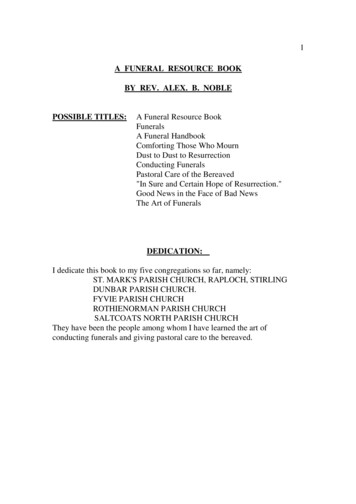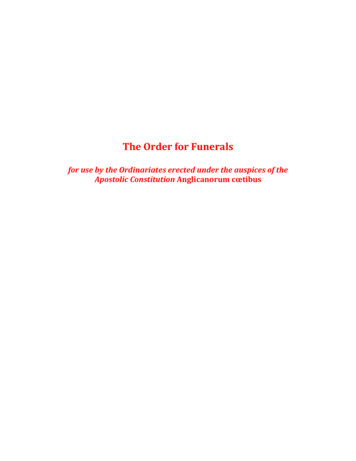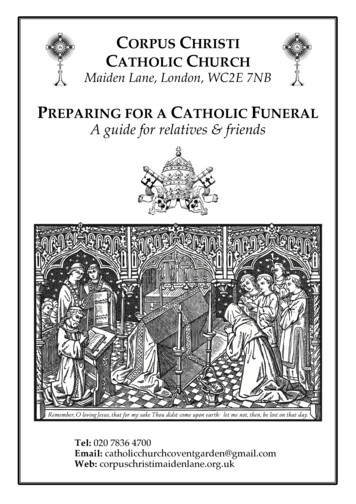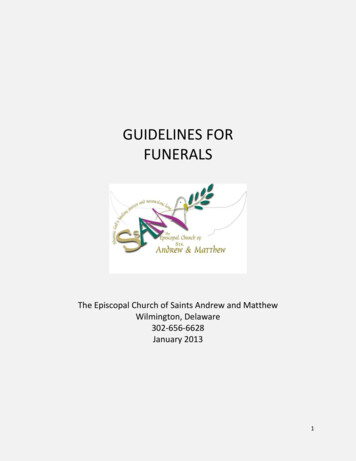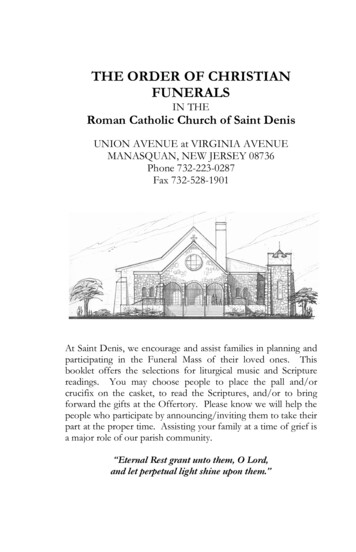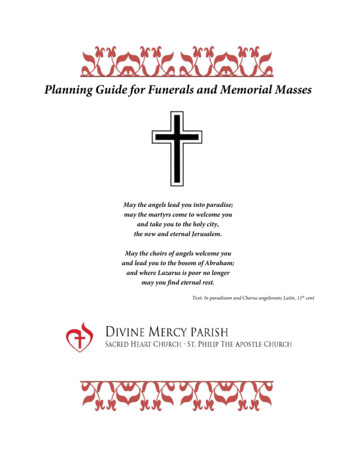
Transcription
Planning Guide for Funerals and Memorial MassesMay the angels lead you into paradise;may the martyrs come to welcome youand take you to the holy city,the new and eternal Jerusalem.May the choirs of angels welcome youand lead you to the bosom of Abraham;and where Lazarus is poor no longermay you find eternal rest.Text: In paradisum and Chorus angelorum; Latin, 11th cent
2
Dear friends: Our prayers and condolences are with you as you gather to plan andprepare this most important liturgy.We thank you for allowing us to assist in you in this most difficult time as we walktogether in our journey of faith. Know of our prayers for you, your family and yourbeloved.Rev. Steven M. Lanza, PastorRev. Dean Semmer, Associate PastorRev. Michael Solazzo, Associate PastorRev. Daniel Cassidy, Priest-in-ResidenceMr. Gerald Keenan, DeaconMr. Michael McNulty, Senior DeaconMr. Robert Puhala, DeaconMr. Ron Vanasdlen, Director of Liturgy and MusicMs. Sarah Cozzi, Associate Director of MusicIf, then, we have died with Christ,we believe that we shall also live with him.(Romans 6:8)3
SCHEDULINGYou may download the Planning Form, complete it, and return it to the Director Musicand Liturgy - rvanasdlen@divinemercynorthshore.orgScheduling of a Funeral or a Memorial Mass may be done by calling the parish office(847) 446-0856Funeral Masses are celebrated Monday through Saturday, based upon the parishcalendar, except for:1) Solemnities that are Holy Days of ObligationAll Sundays of the year, January 1, August 15,November 1, December 8 and December 252) Ash Wednesday3) Observances of the Sacred Triduum –Thursday of Holy Week (Holy Thursday)Good Friday, andHoly SaturdayASH WEDNESDAYFebruary 17, 2021March 2, 2022February 22, 2023February 14, 2024March 5, 2025February 18, 20264SACRED TRIDUUMApril 1 - 4, 2021April 14 - 17, 2022April 6 - 9, 2023March 28 - 31, 2024April 17 - April 20, 2025April 2 – April 5, 2026EASTER TIMEApril 5, 2021 - May 23, 2021April 17, 2022 - June 5, 2022April 19, 2023 - May 28, 2023March 31, 2024 - May 19, 2024April 20, 2025 - June 8, 2025April 5, 2026 – May 24, 2026
THE REALITY OF DEATHThe death of a loved one is wrenching.Grief and tears fill the days. Heavyhearts ache and we can think of nothingelse except the one we love is gone fromthis world.Grief is appropriate. But so is Christianhope. For believers do not grieve asTHE BONDS OF LOVEDeath is not the end. Death does notbreak the bonds of love forged in thislife. There is more to life than meets theeye. Faith informs us that there is muchmore to life than this world. BecauseGod loves us and makes all our humanloving possible, we celebrate Christianfuneral rites to offer worship, praise andthanksgiving to God for the gift of a lifethat has now been returned to God whois the author of life and the hope of thejust (cf. Order of Christian Funerals 5).When a Christian believer dies wegather as a faithful people to intercedepeople without hope. Heaven is our truehome and it awaits us all. Friends ofGod look beyond this world to heaven.It is with this profound hope—alongwith our prayers, sympathy andsupport—that we offer this re-source forfuneral preparations.on behalf of our beloved deceased,confident that God will hear our prayersand that those prayers will assist ourloved one as they approach the divinethrone of mercy and grace.The celebration of a Christian Funeralthus brings hope and consolation to theliving. The funeral acknowledges thatthere truly is a spiritual bond betweenthe living and the dead, a bond madepossible by the Passion, Death andResurrection of Jesus Christ.RITES AT THE DEATH OF A CHRISTIANThree interconnected liturgies mark the passage of a Christian from this world to thenext:The Vigil for the Deceased, or Wake, isusually held at a funeral home, althoughit can be observed in the gathering spaceat Sacred Heart.This is the beginning rite of the funeral.The celebration of the wake service isthe time for the Christian community tooffer both prayer and consolation to thefamily of the one who has died. Thewake service is usually led by a priest ordeacon. The priest or deacon will gathereveryone together in prayer and thenshare a reading(s) from Scripture. Theywill then offer a brief homily on thereading(s) and prayers for the one whohas died and for all those who mourntheir loss. Everyone will then pray theOur Father together and the priest willoffer a concluding prayer and ablessing.The Funeral Mass or the Funeral Outside of Mass (a non-Eucharistic liturgy)5
The Funeral (with or without a Mass) isthe primary celebration of the funeralrites. This Mass celebrates our belief, asChristians, that death is a passage to anew life and, ultimately, to resurrectionand eternal union with God. Theresurrection is the theme that is reflectedin the readings, the hymns/songs andprayers.Mass. Family members or friends of thedeceased can serve as pall bearers, placethe pall on the casket, read sacredscripture, offer prayer intentions andpresent the gifts during the Mass. Afamily member or friend who is anactive Extraordinary of HolyCommunion may ask to participate inthe Mass.As an expression of our faith in JesusChrist everyone in attendance isencouraged to actively participate inthis Mass. The parish clergy and staffmembers will help the family select thereadings, hymns/songs and prayersthat are appropriate for the FuneralThe Funeral Mass/Memorial Mass isusually held in church, although aFuneral Liturgy (Outside of Mass) maybe celebrated at a funeral home(whereas a Mass cannot be celebrated atthe funeral home).The Rite of Committal (burial) is held at the cemetery.The Rite of Committal is celebrated atfuneral unless a good pastoral reasonthe place of burial or interment. In thedictates otherwise such as travel to acommittal of the body to its place ofdistant cemetery. The Church directsrest, we express our hope that thethat the cremated remains of thedeceased will experience the glory of thedeceased must be interred in aresurrection. The committal must beconsecrated burial site.celebrated immediately following theA Memorial Mass, to pray for the deceased, is celebrated at some time following theCommittal.Traditionally, we believe that our bodies are temples of the Holy Spirit, the funeral liturgy iscelebrated by bringing the body to church for the Funeral Mass. However, in 1997 the Holy Seegranted permission for Funeral Masses in the United States to be celebrated with crematedremains being brought to church in a worthy vessel containing the ashes. Following the liturgy,the committal takes place in a grave, mausoleum or columbarium.For as one alone [Christ] accepted death, so thatwe might all escape from dying; as one man hechose to die, so that in your sight we might all lifeforever.(Preface II for the Dead, Roman Missal, English Third Edition, 2010)6
LITURGICAL ELEMENTS OF THE FUNERAL (MEMORIAL) MASSInformation in this guide will assist families and loved ones in preparing the details ofthe Funeral/Memorial Mass, whether the funeral takes place with the body or thecremated remains or takes place following internment.FIRST: Choose the readings for the liturgyFirst ReadingResponsorial PsalmSecond ReadingGospelUniversal PrayerSECOND: Choose the liturgical musicEntranceOffertory (optional Assembly song)CommunionSong of FarewellSendingTHIRD: Choose ministers/participantsPlacing of the PallFirst ReaderSecond ReaderIntercessor (for the Universal Prayer)Presenters of the Eucharistic GiftsFOURTH: Information about Your Loved OneInformation about your loved one is shared with the priest presider. The priest isinterested in knowing some information about your loved one that might be included inthe homily. These questions may help with information to share. Also considerreflection about the selected scripture readings in notes about your loved one and howshe or he modeled their life in their Christian belief. How would your loved one like to be remembered?How would you describe their faith journey?What would he/she be most proud of from their personal life?What was she/he most passionate about?What were his/her most positive traits or characteristics?Is there a particular story or incident that would exemplify their life?How would she/he be described by their closest family and friends?Did he/she have any personal interests that reflect what kind of person theywere?FIFTH: Eulogy or Words of RemembranceIn the Order of Christian Funerals, the speaking in remembrance normally occursfollowing the Prayer after Communion and before the Final Commendation. In the caseof a true pastoral necessity, the presider may direct that the sharing occur before thereception of the body or the cremated remains at the Church (if the reception has notalready occurred) or before the Opening Prayer of the Funeral Liturgy by way of7
introduction. If the sharing occurs at the beginning of the Funeral Mass, another sharingshould not be given after Communion.For a Funeral Outside of Mass or a Memorial Mass, the Words of Remembrance may be offeredbefore the Blessing and Dismissal.The sharing in remembrance of the deceased is not a biography. In keeping withChurch tradition, only one member or friend of the family should speak inremembrance of the deceased at the Funeral Mass. The pastor or presider of the FuneralLiturgy may determine otherwise, but the number who will speak must be determinedbefore the liturgy.The Vigil or wake is the more appropriate time for sharing informal stories about thedeceased. Though not mentioned in the Order of Christian Funerals, a sharing might alsobe given at the burial or interment of the deceased.The sharing is not a time to philosophize about death, but to recall with gratitude theblessings of God for one loved by God and now returned to God. The sharing shouldnot take more than 3 minutes.ENVIRNOMENTSpecial environmental elements for liturgical seasons during 1) Advent, 2) Lent, 3)Christmas or 4) Easter Time remain in church for funeral celebrations. Additionalflowers, however, can be added.I believe the words of the wise, that is, thatevery fair and God-beloved soul, when itleaves here and is set free from the bonds ofthe body, at once enjoys a sense andperception of the blessings that await.Saint Gregory of Nazianzus (On His Brother Caesarius, Oration, 7.21,in Ancient Christian Doctrine, vol 5, p 257, ed., Angelo Di Berardino, IVPAcademic, Downers Grove, IL, 2010)8
FUNERAL LITURGY (MASS)Introductory RitesGreetingSprinkling with Holy WaterPlacing of the PallEntrance Hymn or SongCollect (Opening Prayer)Liturgy of the WordFirst ReadingResponsorial PsalmSecond ReadingGospel AcclamationGospel ReadingHomilyUniversal PrayerLiturgy of the EucharistOffertory Hymn or SongPreparation of the GiftsEucharistic Prayer with AcclamationsThe Lord’s PrayerCommunion Hymn or Song (s)FUNERAL LITURGY(OUTSIDE OF MASS)Introductory RitesGreetingSprinkling with Holy WaterPlacing of the PallEntrance Hymn or SongCollect (Opening Prayer)Liturgy of the WordFirst ReadingResponsorial PsalmSecond ReadingGospel AcclamationGospel ReadingHomilyUniversal PrayerFinal CommendationSong of FarewellProcessional to the Place of Committal(Sending Hymn or Song)Final CommendationSong of FarewellProcessional to the Place of Committal(Sending Hymn or Song)9
MEMORIAL MASSIntroductory RitesEntrance Hymn or SongGreetingPenitential ActCollect (Opening Prayer)Liturgy of the WordFirst ReadingResponsorial PsalmSecond ReadingGospel AcclamationGospel ReadingHomilyUniversal PrayerLiturgy of the EucharistOffertory Hymn or SongPreparation of the GiftsEucharistic Prayer with AcclamationsThe Lord’s PrayerCommunion Hymn or Song (s)Concluding RitesBlessingDismissalSending Hymn or Song10MEMORIAL LITURGY(OUTSIDE OF MASS)Introductory RitesEntrance Hymn or SongGreetingPenitential ActCollect (Opening Prayer)Liturgy of the WordFirst ReadingResponsorial PsalmSecond ReadingGospel AcclamationGospel ReadingHomilyUniversal PrayerConcluding RitesBlessingDismissalSending Hymn or Song
SYMBOLS USED AT THE FUNERAL LITURGYA Catholic funeral liturgy celebrates thePassion, Death and Resurrection ofChrist and how, through Baptism, thedeceased shares in the life of Christ. At aCatholic funeral liturgy many symbolsare used to express the dignity of thedeceased as a child of God.The funeral liturgy begins with thereception of the body when the Presidersprinkles the coffin or urn with HolyWater as a remembrance that in thewaters of baptism Christians receive thepledge of eternal life. Then the coffin iscovered with a funeral pall, a clothwhich drapes the casket during theliturgy. The pall symbolizes the whitebaptismal garment that the deceasedreceived on the day of their Baptismwhen they, as St. Paul tells us, “put onChrist”. The pall is a sign of theChristian dignity of the person and thatall are equal in the eyes of God. Familymembers are invited to place the pall onthe casket.Draped with the pall, the coffin is nowmoved to the base of the sanctuarywhere the Paschal Candle stands. ThePaschal Candle represents Christ, theLight of the World. The Paschal Candlereminds us of Jesus’ victory over sin anddeath and of our participation inChrist’s victory because of our Baptism.It reminds us, too, of our own Baptismwhen we received a Baptismal candlewhich was lit from the Paschal Candleand told that we have been enlightenedby Christ and are to always walk as achild of the light. The priest wears whitevestments when celebrating a funeralliturgy because this color is associatedwith resurrection.At some point during the funeralliturgy, usually at the end, the coffin orthe cremated remains is incensed.Incense is used as a sign of honor to thebody of the deceased, which throughBaptism became a temple of the HolySpirit. Incense is also used as a sign ofthe community's prayers for thedeceased rising to the throne of God andas a sign of farewell.V. Requiem aeternam dona eis, Domine.R. Et lux perpetua luceat eis.V. Eternal rest grant unto them, O Lord.R. And let the perpetual light shine uponthem.Fidelium animae, per misericordiam Dei,requiescant in pace.Amen.And may the souls of all the faithfuldeparted, through the mercy of God, restin peace. Amen.From the Enchiridion of Indulgences #46 and the Raccolta #582 (S. C. Ind., Feb. 13, 1908; S. P. Ap., May 17, 1927)11
All the sacraments, and principally those of Christian initiation, have astheir goal the last Passover of the child of God which, through death,leads [the deceased one] into the life of the Kingdom. Then what [we]confessed in faith and hope will be fulfilled: “I look for the resurrection ofthe dead, and the life of the world to come.”(Catechism of the Catholic Church, n 1680)Divine Mercy ParishSacred Heart Church 1077 Tower Road, Winnetka, Illinois847.446.0856St. Philip the Apostle Church 1962 Old Willow Road,Northfield, IL 847.446.8383www.divinemercynorthshore.org12
The Rite of Committal is celebrated at the place of burial or interment. In the committal of the body to its place of rest, we express our hope that the deceased will experience the glory of the resurrection. The committal must be celebrated immediately following the funeral unless a good pastoral reason dictates otherwise such as travel to a

